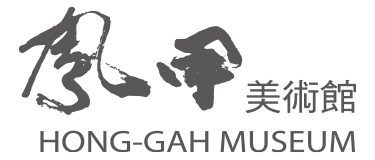The Other Side – Light within the Embroidery
Light within the Embroidery
Embroidery in China has long developed a close relationship with belief systems and spirituality. This section opens with recreated embroideries based on imagery excavated from the Mawangdui tombs, revisiting how early embroidery served not only as decoration but also as a medium of religious expression and metaphysical inquiry. These funerary textiles from the Han Dynasty often depict a layered cosmology of heaven, earth, and the underworld, forming vivid visual narratives of divine beings, spiritual exchanges, and the journey of the soul. Such imagery reflects the aristocratic beliefs about the afterlife, offering rare insight into ancient Chinese views on death and the spiritual realm.
The section also explores embroidery’s role in religious and mythological storytelling. Works inspired by classical texts such as The Scroll of Eighty -Seven Immortals, Gatherings of Immortals to Bless Longevity, and The Nine Songs illustrate how threadwork brings divine figures, celestial rituals, and spiritual longings to life. These embroideries speak to the enduring influence of belief systems on artistic expression. Western religious imagery is also represented in this section, adding another layer to embroidery’s spiritual expressions.Christian iconography, images of saints, and symbolic depictions of divinity reveal embroidery’s remarkable capacity to engage with diverse cultural frameworks. In doing so, the medium demonstrates both its flexibility and its openness—absorbing different visual vocabularies into a shared language of devotion and artistry.
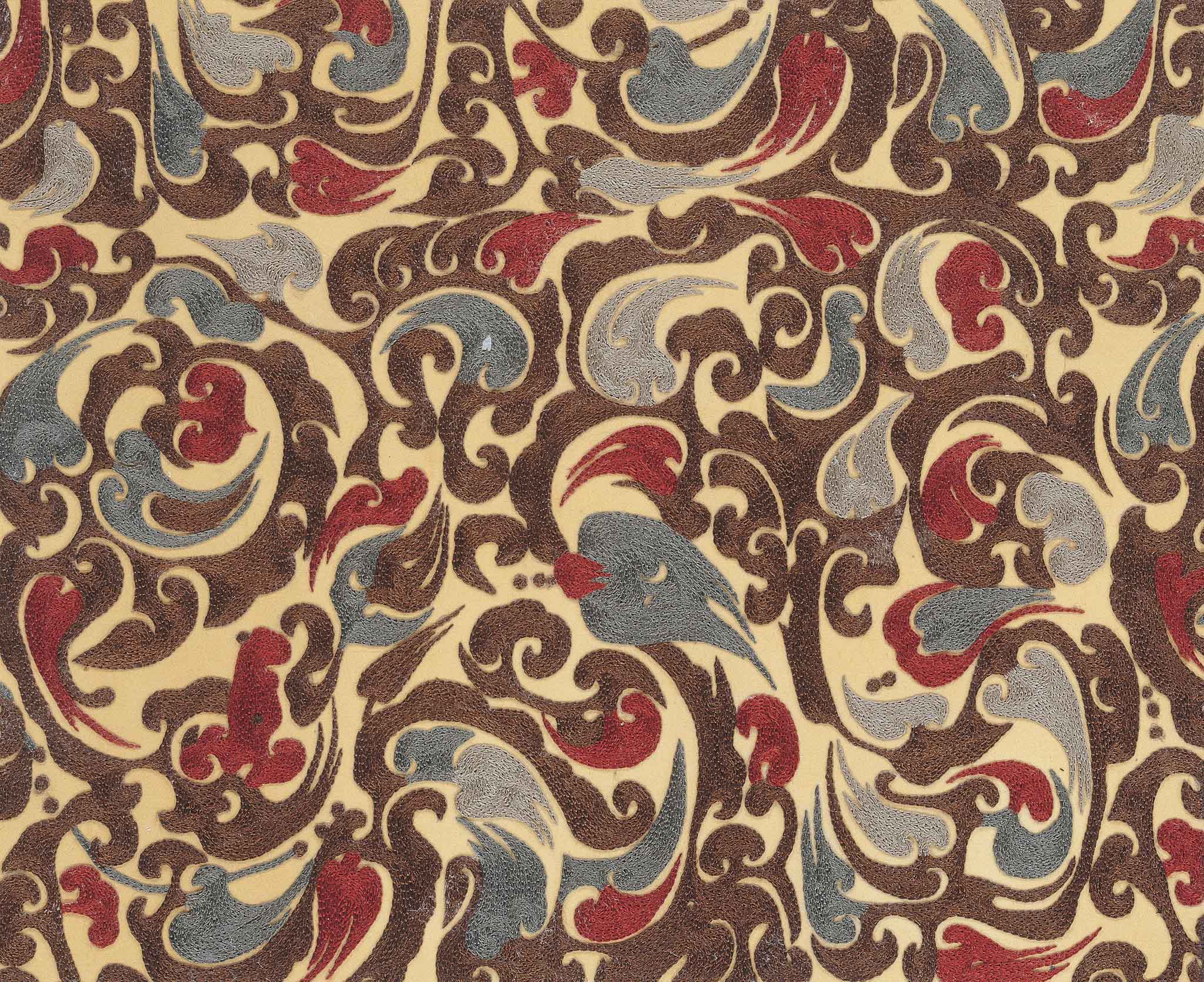
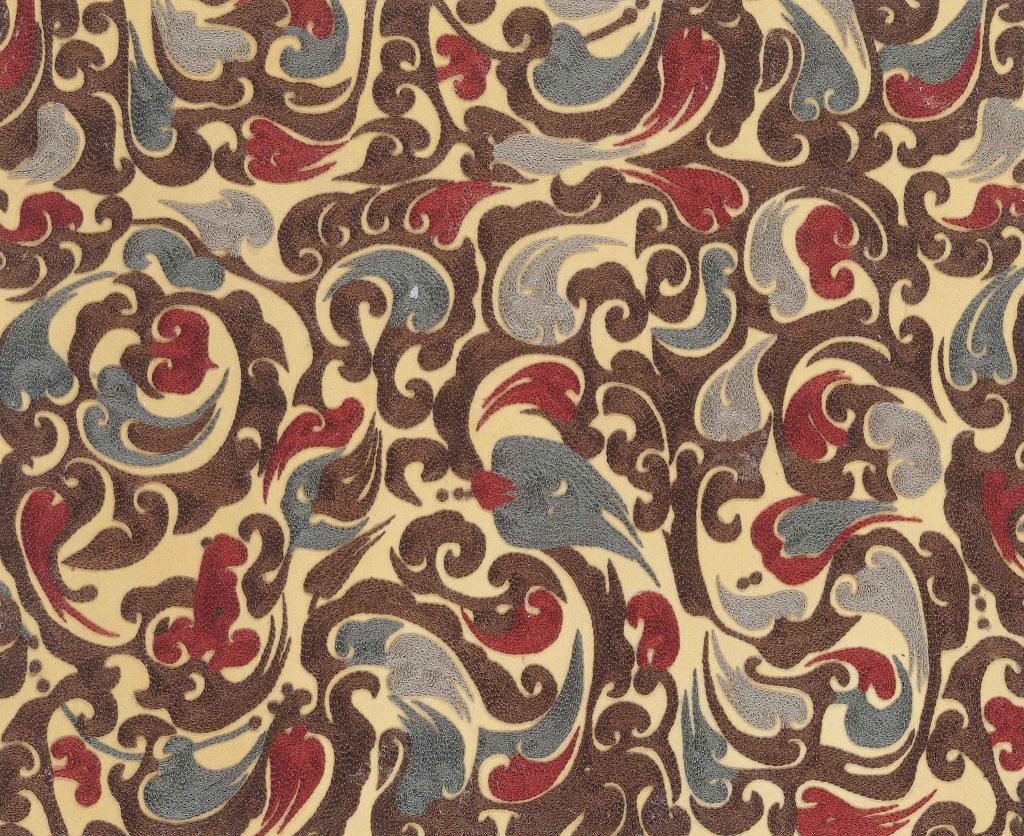
31. Replicas of Embroideries Unearthed from Mawangdui
Suzhou Embroidery. Gu Wen-Xia Emboridery Studio.
Each 31.5 × 39.5 cm, 1990s
In 1972, a series of exquisite embroideries was excavated from the Han Dynasty tombs at Mawangdui in Changsha, Hunan, China. These textiles feature a wide variety of decorative patterns, including birds, auspicious clouds, plants, and geometric design. They are considered some of the most refined examples of early Chinese embroidery. Key designs include Xinqi Embroidery, showing stylized swallows and flora symbolizing the timely return of migratory birds, and the Cloud-Riding Embroidery and Longevity Embroidery, which depict divine beasts and cloud motifs to evoke immortality and transcendence. The pieces in this exhibition are faithful reproductions of the originals, meticulously crafted to recapture the artistic style and technical sophistication of over two millennia ago.
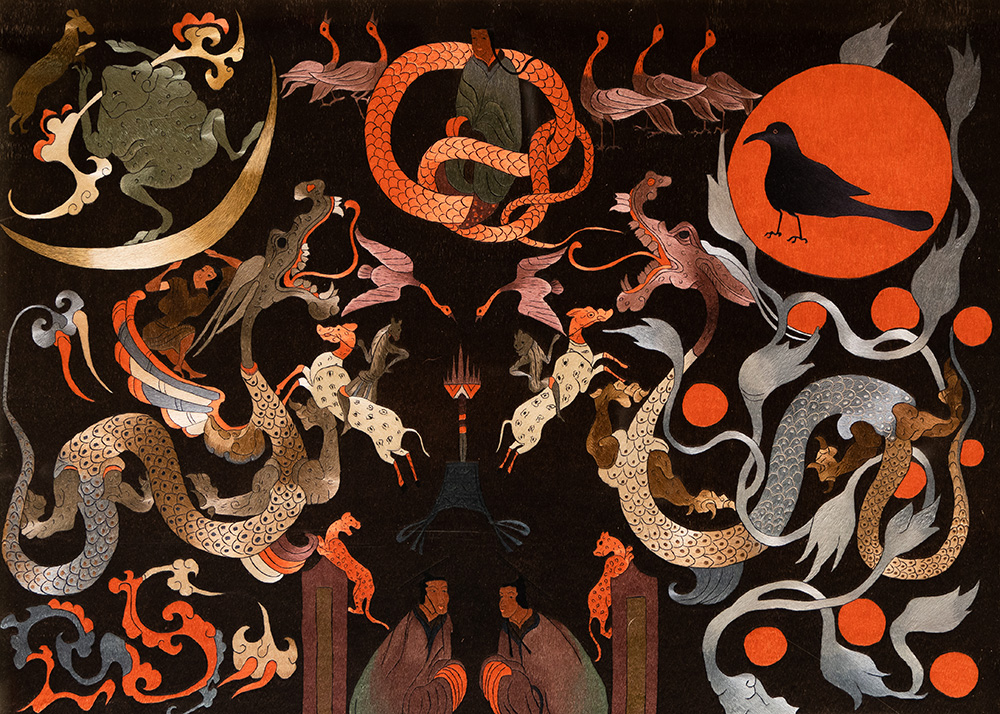

32. Embroidered Replicas of the painting on silk from Mawangdui
Hunan Embroidery. Hunan Embroidery Research Institute
216.5 × 111.5 cm, 1990s
A remarkably well-preserved T-shaped silk painting was unearthed from the Mawangdui tombs. Believed to have served as a funeral accessory to signify the deceased’s identity, this ceremonial textile was intended to guide the soul of the deceased toward the afterlife, symbolizing transcendence and eternal life. The image is structured into three cosmic realms—heaven, earth, and the underworld, reflecting ancient Chinese cosmological beliefs and ideas about the cycle of life and death. The upper register depicts celestial beings, such as the solar crow, the jade rabbit and toad in the moon, and goddess Nüwa, all surrounded by auspicious birds. In the middle section, the tomb’s occupant is shown walking westward, entering the realm of bliss. The lower register portrays the underworld, where an earth deity holds up the ground, beneath which lies the Yellow Springs (realm of the dead). This embroidered version faithfully follows the original structure and spirit of the painting, capturing both the funerary culture and spiritual worldview of the Han Dynasty. It stands as a vital material testimony to the visual culture, religious beliefs, and afterlife imagination of ancient China.
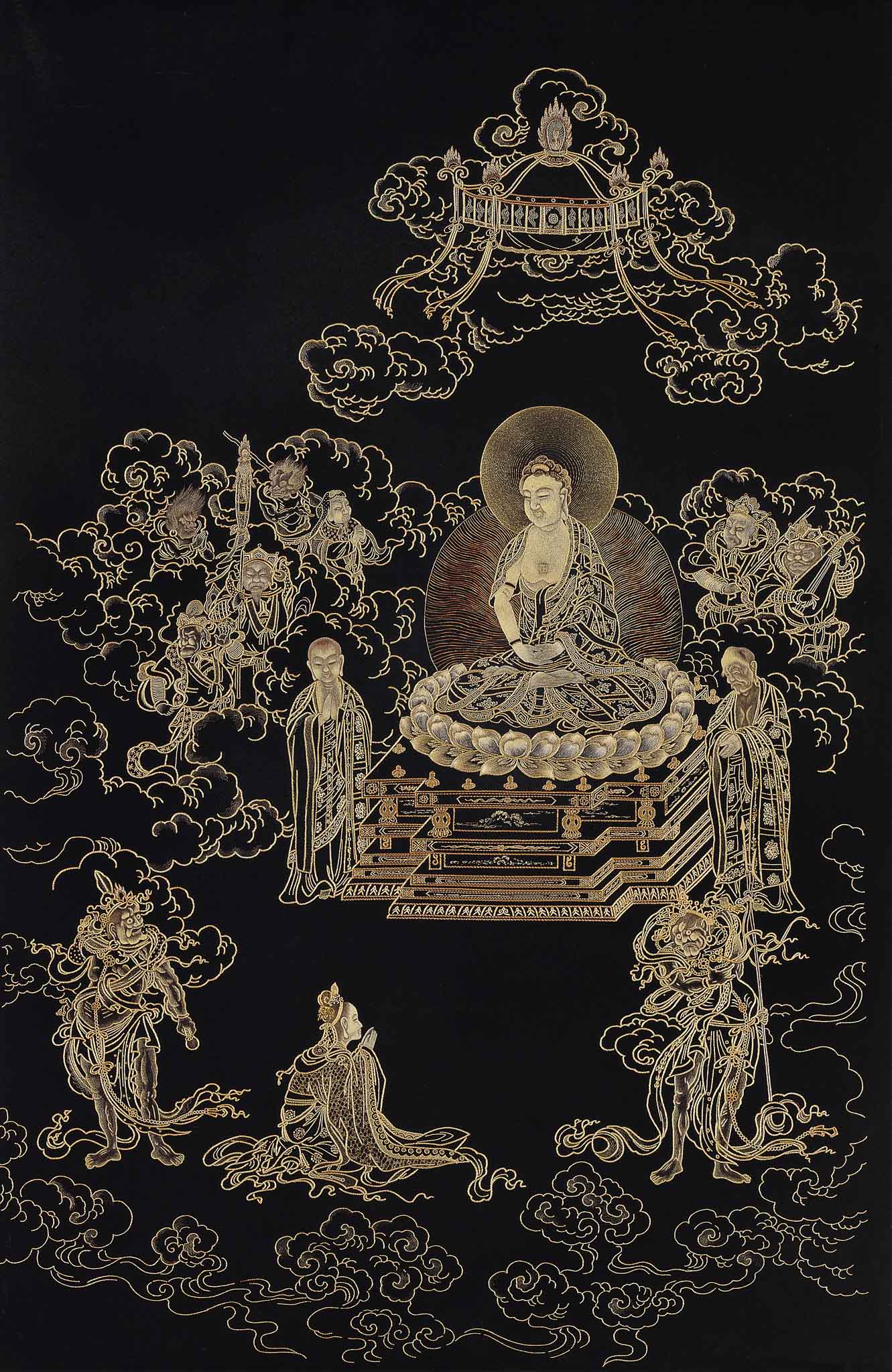
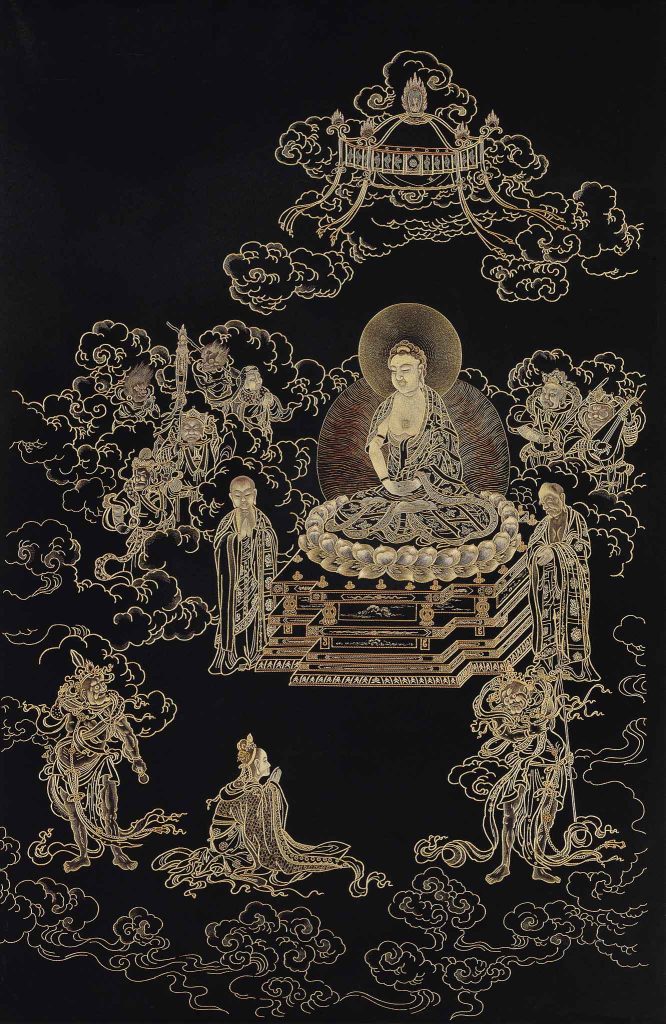
33. Embroidery of Ding Guanpeng’s Buddha with Couching Stitch
Hunan Embroidery.
226 × 106 cm
This piece is adapted from a Buddha painting by Ding Guan-Peng, a prominent court painter of the Qing Dynasty known for his Buddhist and Daoist imagery. At the center sits the Buddha, flanked by the Four Heavenly Kings, two disciples, and gate gods. In the foreground, a worshipper kneels in solemn devotion, evoking a richly spiritual atmosphere. The original painting, executed in gold pigment on indigo paper, is marked by its meticulous detail and radiant surface. In this embroidered version, designed by former Hunan Embroidery Institute director Huang Cui-Feng, gold threads are couched onto the fabric (Couching Stitch), a technique that recreates the luminous, ceremonial quality of the original while showcasing the ornate possibilities of textile as a devotional medium.
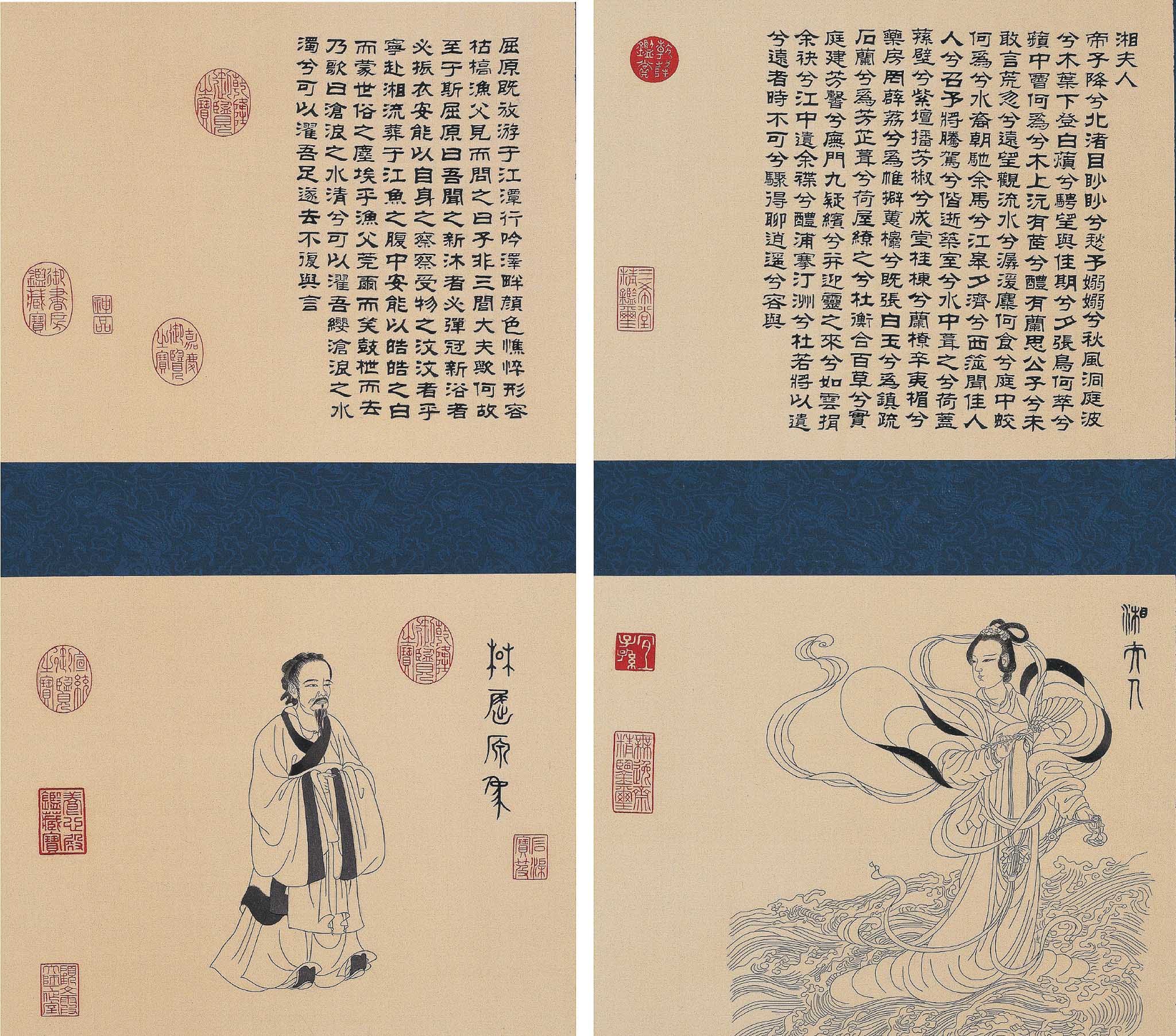
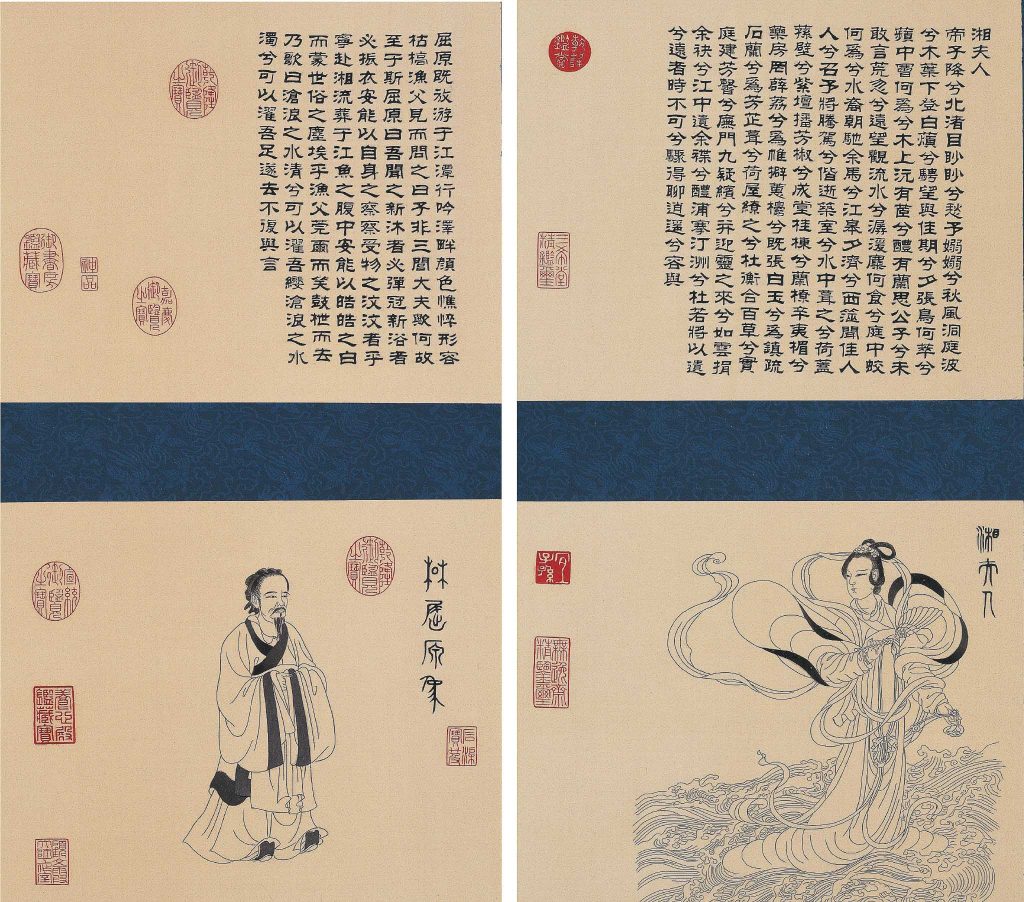
34. Embroidery of The Nine Songs by Zhang Wo
Suzhou Embroidery. Gu Wen-Xia Emboridery Studio
Each 80 × 53.5 cm, 1990s
This embroidered series is based on The Nine Songs, a Yuan Dynasty painting by Zhang Wo, which itself draws inspiration from the Songs of Chu attributed to the ancient poet Qu Yuan. Despite the title, the original work contains eleven ritual hymns portraying sacred ceremonies and interactions between humans and deities. These poems express a profound spiritual connection and are often interpreted as symbolic reflections of loyalty and longing. Zhang’s painting vividly captures these divine rituals with delicate brushwork and poetic nuance. The embroidery translates his lines into thread through Long and Short Stitch , creating a flowing rhythm and lending the figures an ethereal and mystical presence.
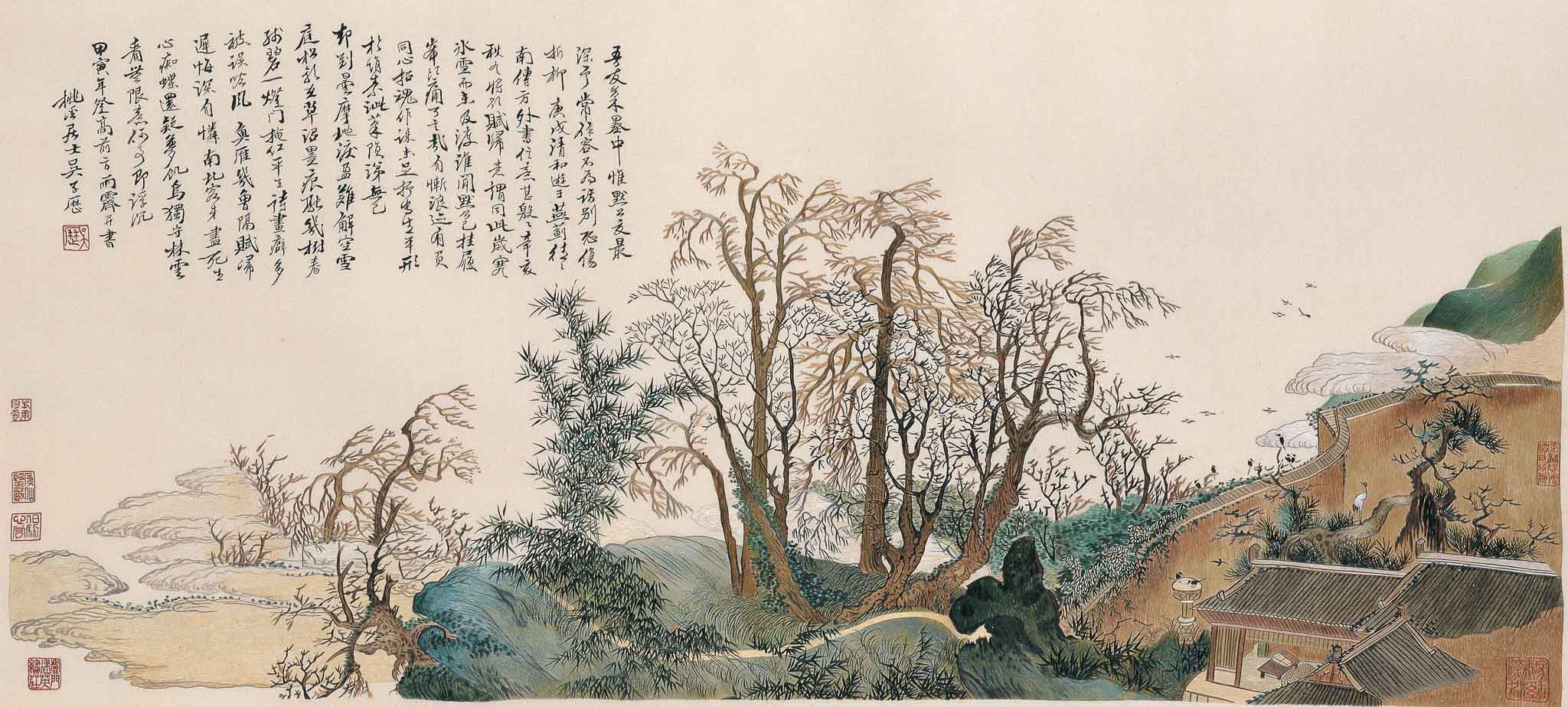
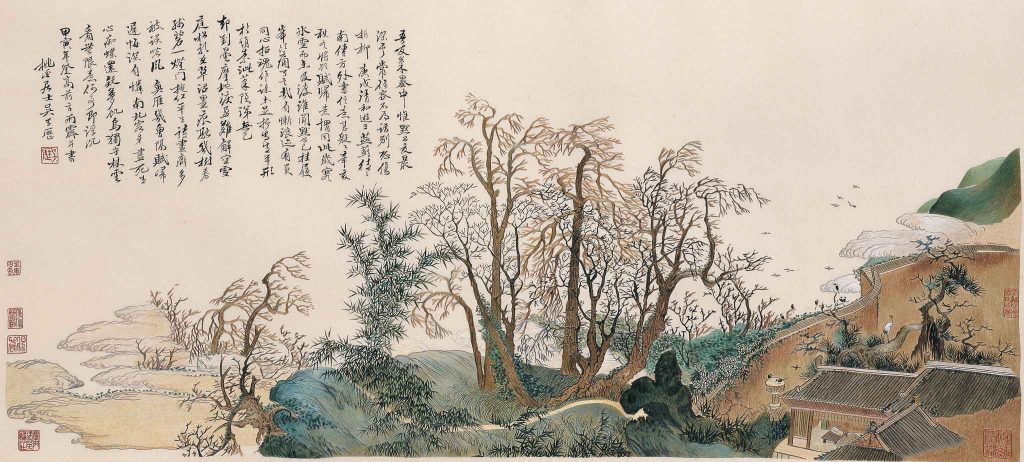
35. Embroidery of Wu Li’s The Memory of Xingfu Temple
Suzhou Embroidery. Lu Jian-Ying Embroidery Studio
52.5 × 87.5 cm, 1990s
This embroidered piece is based on The Memory of Xingfu Temple, a painting by Qing Dynasty artist Wu Li (1632–1718), created in memory of his late friend, the monk Morong. The scene depicts the quiet surroundings of Xingfu Temple in Zhejiang: bare trees with crows circling above, and a solitary crane perched on a pine branch within the temple walls. The sparse, melancholic landscape evokes a sense of absence and longing—an elegy for the past and a meditation on impermanence. Wu was a devout Buddhist in his early life and thus formed a close spiritual bond with the monks at Xingfu Temple, particularly Morong. He later converted to Catholicism in Macau, reflecting the layered spiritual journey that shaped his art. This embroidery, executed in delicate Straight Stitch, skillfully translates the mood and brushwork of Wu’s painting into thread, preserving the original’s emotional resonance and quiet introspection.


36. Embroidery of The Scroll of Eighty-Seven Immortals
Suzhou Embroidery. Suzhou Embroidery Art Museum
39.5 × 427 cm
This monumental embroidered scroll is based on The Scroll of Eighty-Seven Immortals, a masterpiece in Chinese art history. The original work is traditionally attributed to Wu Zong-Yuan of the Northern Song Dynasty, though some scholars believe it to be the work of the Tang Dynasty artist Wu Dao-Zi. The composition portrays a grand procession of Daoist deities and immortals ascending toward the celestial realm. The figures, rendered in flowing robes and composed postures, move in orderly ranks through ethereal clouds, creating a scene that is both majestic and serene. Using exceptionally fine silk threads, the embroidery captures the precision and clarity of the original ink-line drawing on silk, skillfully rendering each immortal’s distinct features, attire, and bearing.
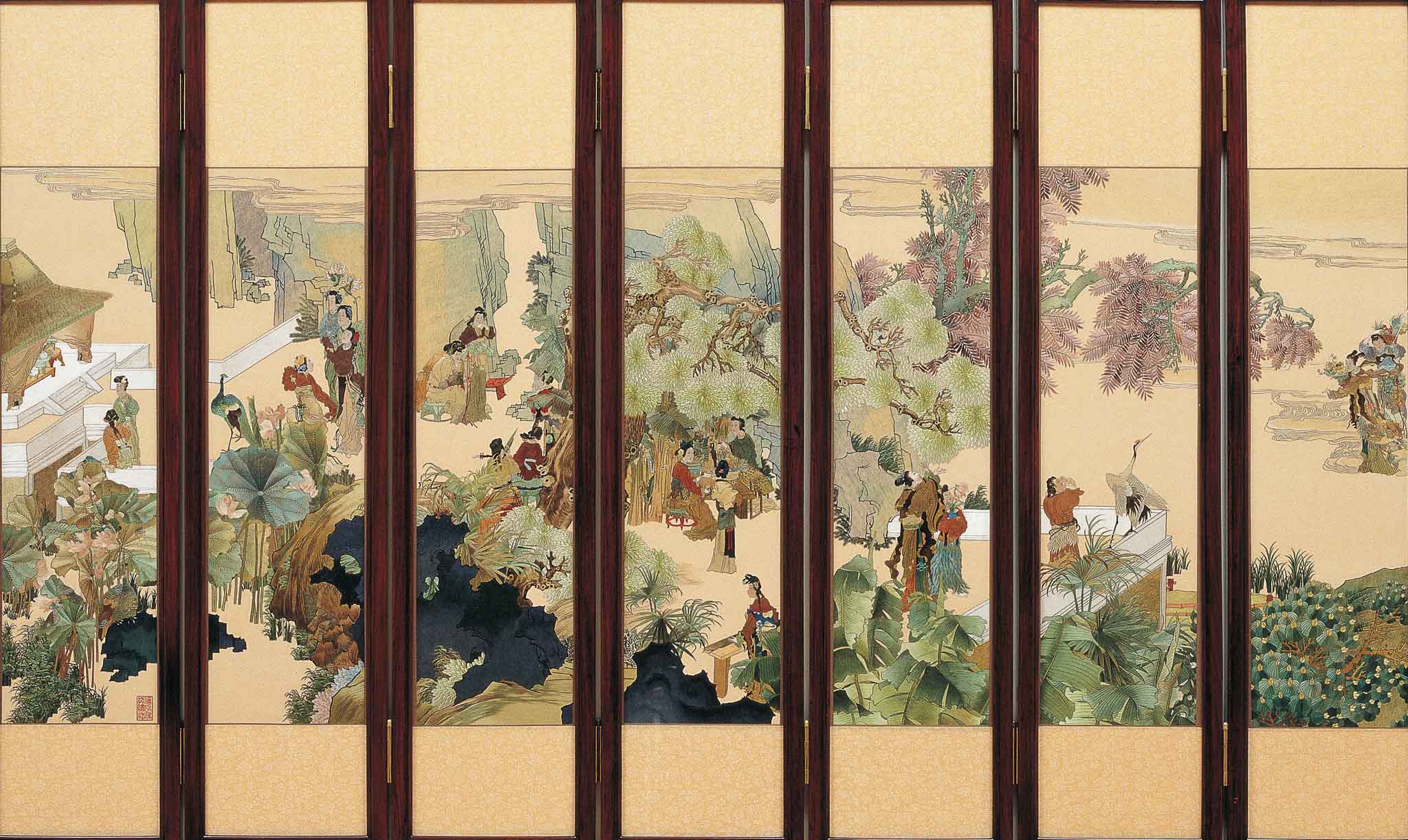
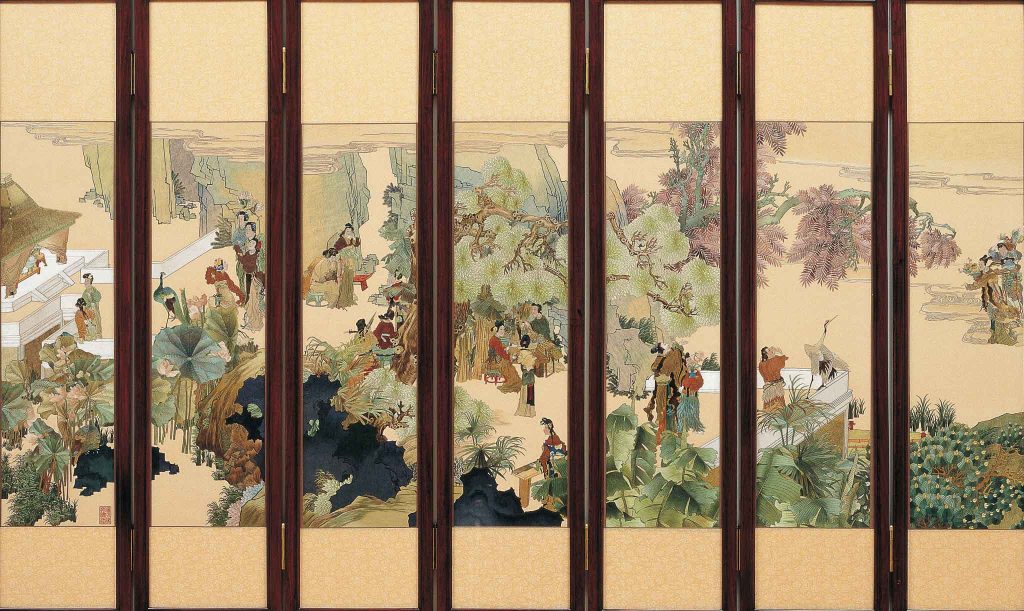
37. Embroidery of Ren Bo-Nian’s Gatherings of Immortals to Bless Longevity
Suzhou Embroidery. Pan Jian-Ying Embroidery Studio
167 × 206 cm, 1998
This monumental twelve-panel embroidered screen is based on Gatherings of Immortals to Bless Longevity, a celebrated work by Ren Bo-Nian, a leading figure in late Qing Dynasty painting. The composition depicts a grand celestial gathering, where groups of immortals arrive to offer birthday blessings to the Queen Mother of the West, a prominent deity in Daoist mythology. A total of forty-six immortals appear across the screen, portrayed in animated, richly varied poses—some carry precious offerings, others dance or perform music—amidst mythical beasts, rare treasures, and auspicious landscapes. The embroidery captures the original painting’s exuberance through masterful needlework, using a combination of vertical and slanted Straight Stitch to portray detailed human figures, animals, and natural scenery. Notably, the reverse side of the screen bears a lengthy inscription detailing the meaning of the original artwork, along with the history and technical legacy of the Pan Jian-Ying Embroidery Studio. Though rendered in ink rather than thread, this text forms an elegant counterpart to the embroidered surface.
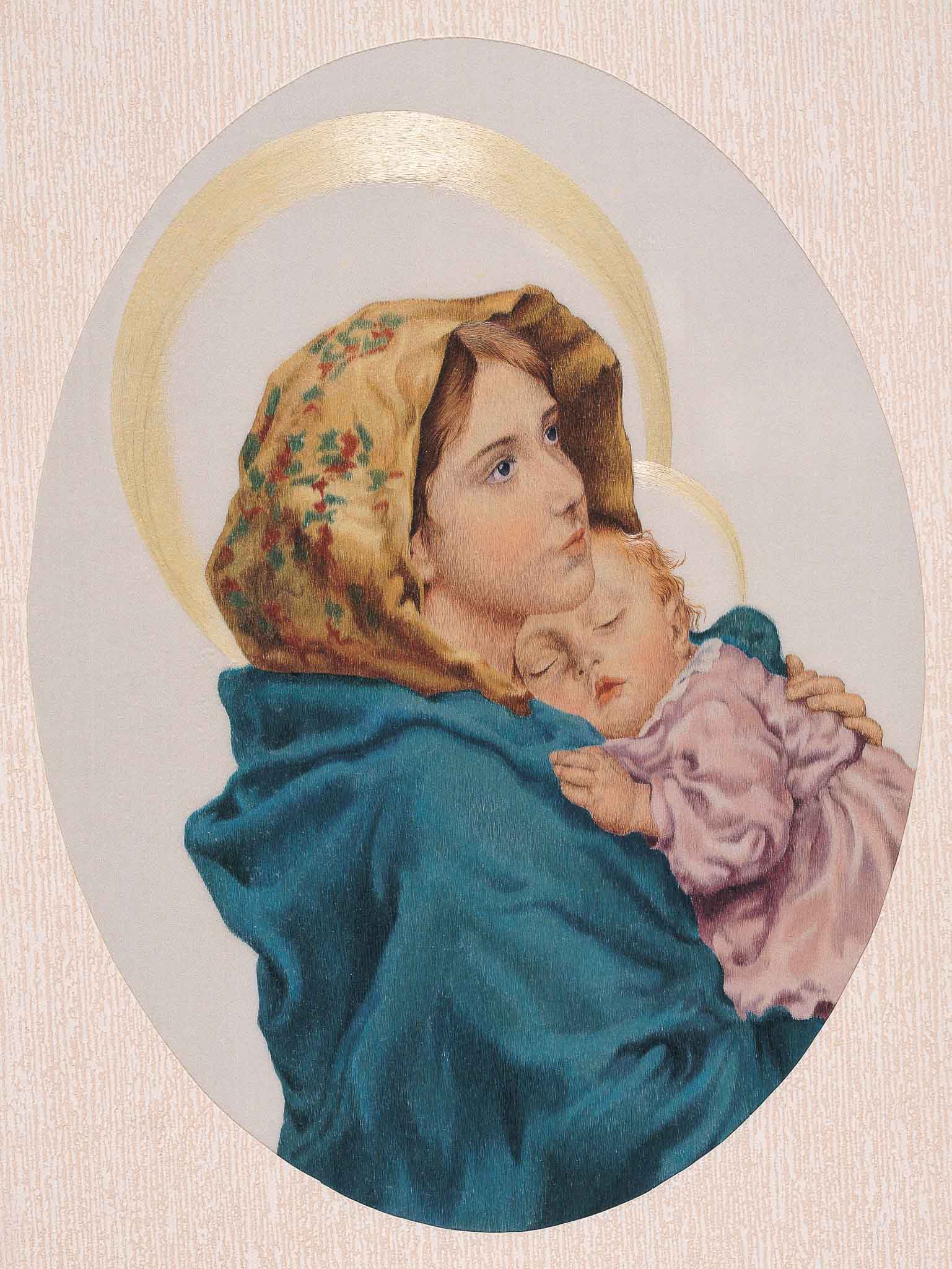
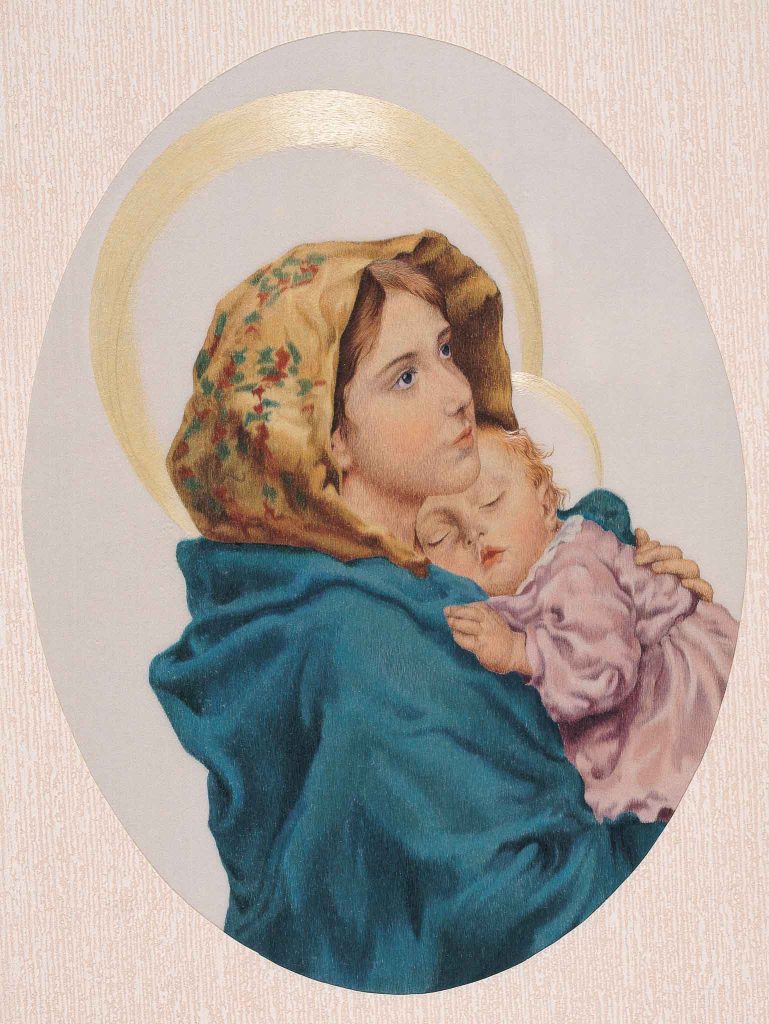
38. The Madonna and Child
Suzhou Embroidery. Suzhou Embroidery Research Institute
67.5 × 55.5 cm, 1995
The work depicts the well-known Christian motif of the Madonna and Child. The Virgin Mary, draped in a floral-patterned veil, gazes gently upward with a serene and contemplative expression. In her arms, the sleeping infant rests peacefully, lips slightly parted. Both mother and child are encircled by golden halos, imbuing the scene with quiet reverence and sanctity. As Suzhou Embroidery entered the global art market, local studios and factories began producing works inspired by Christian iconography, responding to international aesthetic tastes. This piece demonstrates the medium’s adaptability and technical brilliance, using layered Straight Stitch to create delicate color gradations in skin and drapery, achieving a high degree of realism and emotional subtlety.
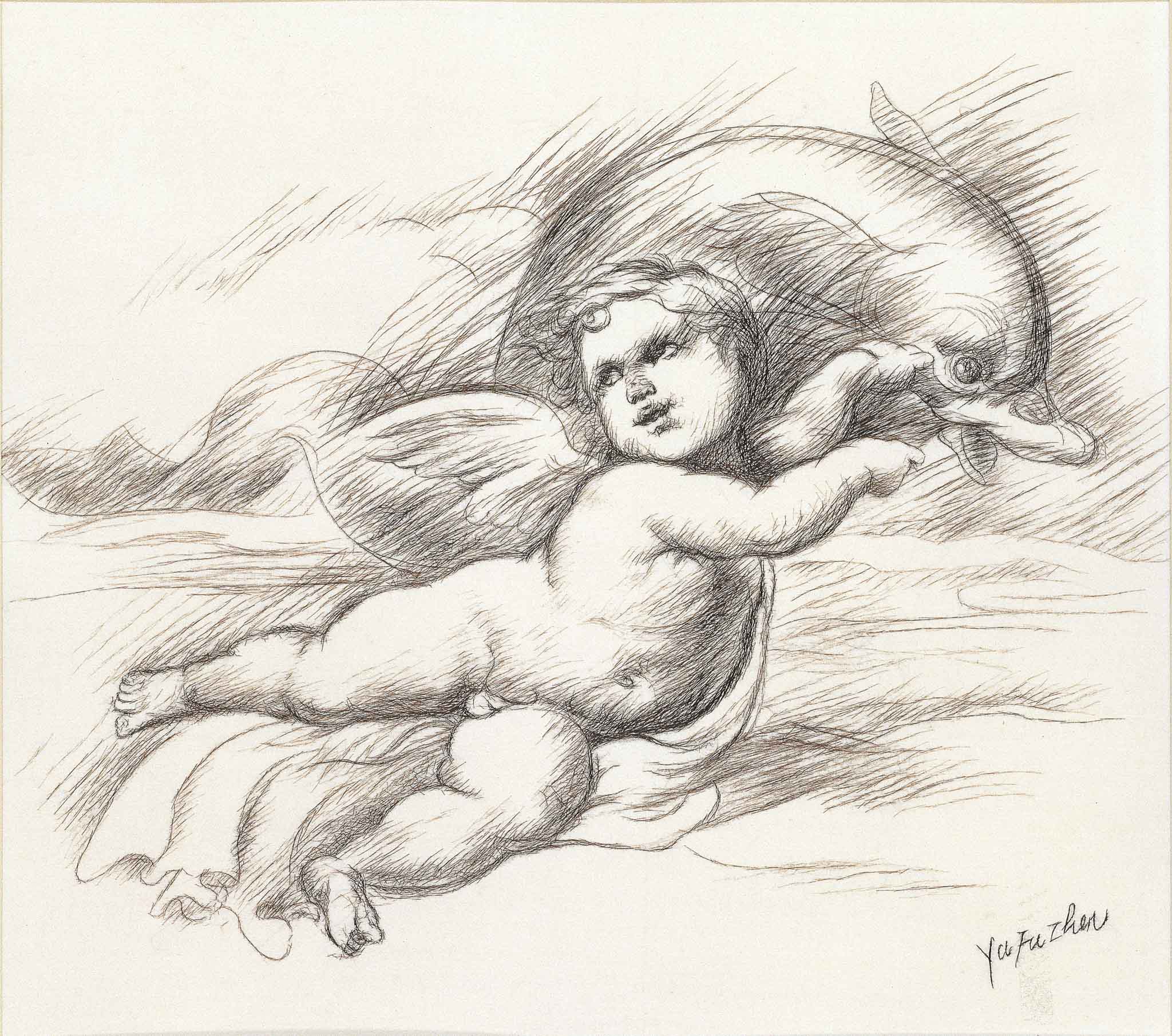
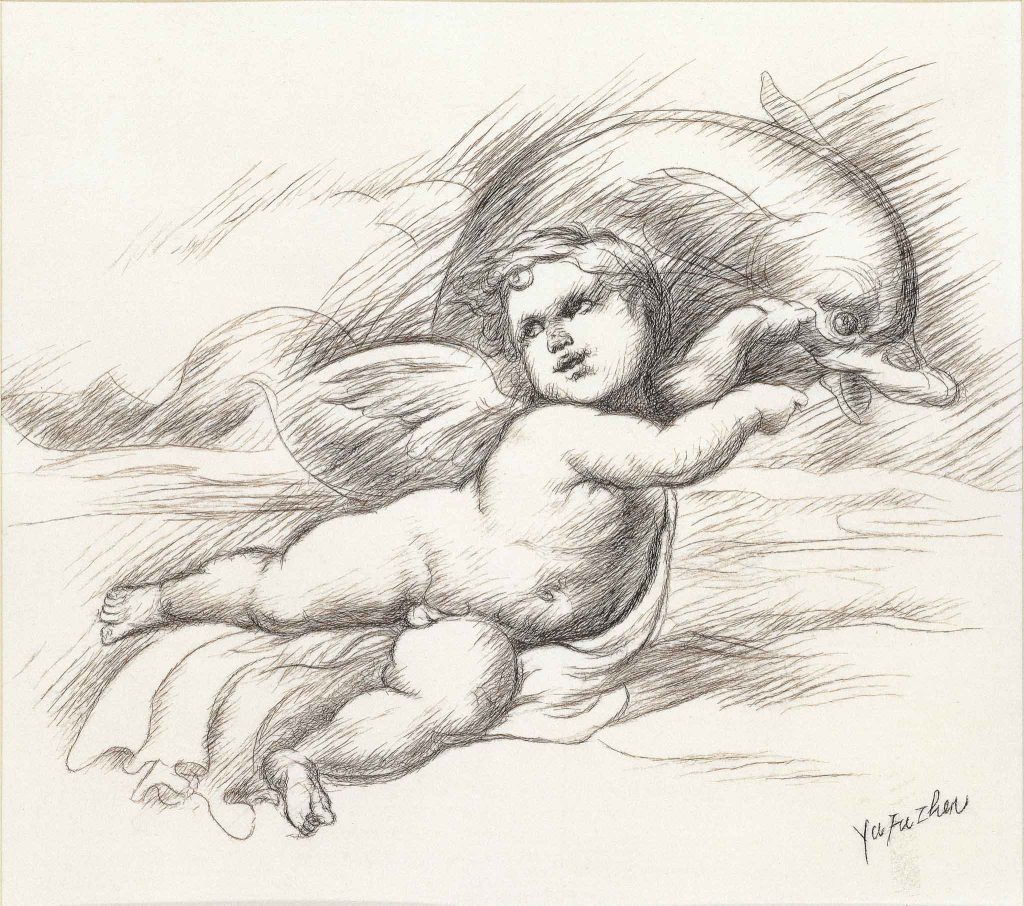
39. Child and Dolphin
Suzhou Embroidery. Embroidery: Yu Fu-Zhen
63 × 68 cm, 1995
This embroidery portrays a winged child in playful harmony with a leaping dolphin—an image that likely draws inspiration from the classical Western motif of Cupid and the dolphin. Common in Roman antiquity and Renaissance art, this pairing symbolizes innocence and protection. Yu Fu-Zhen masterfully employs threads of diverse ink to simulate the tonal gradations of pencil on paper. The embroiderer evokes the subtle texture and depth of graphite, revealing the expressive possibilities of thread as a medium and its capacity to transcend material boundaries.
